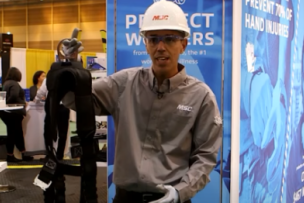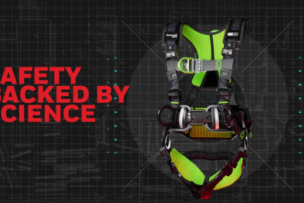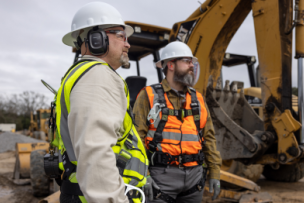Understanding OSHA Ladder Regulations and Compliance
OSHA’s general industry requirements for ladders (1910.23) describe the physical attributes and restrictions for using various types of ladders. The standard includes general requirements for all ladders and specific requirements for portable ladders, fixed ladders, and mobile ladder stands and platforms. For example, the regulations say:
- Steps of ladders must be uniformly spaced and have a slip-resistant surface.
- Mobile ladder side rails must not exceed 60 degrees of slope.
- Mobile ladders and platforms must be capable of supporting at least four times the maximum intended load, which includes the weight of the user and all tools and materials being carried.
- Ladders must be used on a stable, level surface, or secured to prevent movement during use.
- Portable ladders used to access a landing surface must have side rails that extend 3 feet above the surface.
Beyond the agency’s regulations, OSHA recognizes the American National Standards Institute (ANSI) as the standard-setter for ladders. ANSI’s A14 standard covers portable wood ladders, portable metal ladders and fixed ladders.
When choosing ladders for the workplace, make sure they conform to OSHA and ANSI regulations.
Ladder Inspection Checklists: Identifying Risks Before Climbing
OSHA requires that ladders are inspected before each work shift, or more frequently if necessary, “to identify any visible defects that could cause employee injury.”
Blankinship recommends that workers inspect a ladder every time they use it. “The reason for that is you don’t know who touched it last in a busy jobsite,” he says, “and you don’t know if a forklift ran over it, or what else happened to it.”
Read more: Ladder Safety Tips: What You Need to Know to Protect Your Workers
Steve Towne, vice president of sales at Ballymore Safety Products, a manufacturer of steel rolling ladders, says it’s good practice for the workplace to have a checklist for ladder use.
“All the components from the handrails to the rear vertical to the base assembly to the casters are all key components that you can visually inspect before use,” he says.
“For any ladder,” he continues, “you definitely want to make sure all decals and labels are legible, the instructions are clearly printed on the ladder, and all the components of the ladder itself are deemed in good working manner.”
To help workers know what to check, Werner created an inspection form for each type of ladder it manufactures, including stepladders, podiums and extension ladders.
“You want to go through the steps and check the rails, the labels, the pail shelf, the top, the spreader,” Blankinship says. “Check the general construction. Do you notice any rust or corrosion, anything that’s loose, like bracing shoes or rivets?”
Ladders that have defects must be labeled with “Dangerous: Do Not Use” or similar language per OSHA’s accident prevention signs standard (1910.145) and taken out of service until repaired.
The American Ladder Institute (ALI), which develops the ANSI standards, says that any ladder with a broken or bent side rail should not be repaired and instead should be destroyed.
Height Safety Training: Teaching Workers How to Use a Ladder Safely
In the rush to get things done, it can be tempting for workers to skip critical steps that would keep them safe and avoid costly corporate fines. That’s why employers must take ladder safety seriously and teach people how to use ladders safely.
“Creating a safety culture on the job can really save yourself a lot of pain and suffering and allow you to get your job done, too,” Blankinship says.
Read more: OSHA’s Top 10 Violations 2024: Fall Protection Still No. 1
Here are some do’s and don’ts of ladder safety, with input from Blankinship and Towne:
- DO use the appropriate ladder for the job.
- DON’T set up a stepladder on an uneven surface, like in a stairwell.
- DO make sure the locks are spread (for stepladders) or the lockstep is engaged (for rolling ladders) and all four feet are on the floor.
- DON’T use a ladder on a slippery surface.
- DO have only one person on the ladder at a time, unless it is specifically designed for two people.
- DON’T lean a stepladder against a wall, unless it’s made for that purpose.
- DO keep your body centered in a stepladder or extension ladder. “We always say to keep your belt buckle inside the rails,” Blankinship says.
- DON’T stand or sit on the second step from the top or on the top of a stepladder.
- DO maintain at least three points of contact on the ladder—for example, two feet and one hand, or two hands and one foot.
- DON’T “walk” a stepladder, or move the legs while you’re on it. “This is probably one of the most-cited things on the jobsite,” Blankinship says.
Thankfully, many training tools exist to help employers create a ladder safety program that educates workers and empowers them to be safe. For example, OSHA has a guide to rules for stairways and ladders, and the American Ladder Institute offers free ladder safety training. Companies such as Werner provide safety training resources for ladders and fall protection.
Also, distributors, such as MSC Industrial Supply, and ladder manufacturers have certified safety professionals on staff who can go into facilities and advise on safety issues.
“Safety is of the utmost importance,” says Ballymore’s Towne. “When we work with safety individuals, we want to understand what their concerns are, what they’re faced with in the day to day. And then we work with those safety professionals to develop solutions that will help productivity but also get their employees home safe each and every night.”
What changes would you make to improve ladder safety in your workplace? Let us know in the comments.





Talk to Us!
Leave a reply
Your email address will not be published. Required fields are marked *